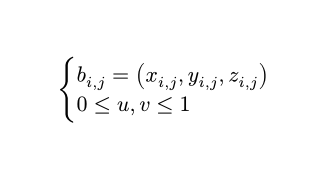I want to create an equation like the bottom part of:
I was able to do this
$ cases(
b_(i,j) = (x_(i,j), y_(i,j), z_(i,j)),
#$0<=u,v<=1$)
$

any way to do this with leaving and entering math mode (#$...$)?
I want to create an equation like the bottom part of:
I was able to do this
$ cases(
b_(i,j) = (x_(i,j), y_(i,j), z_(i,j)),
#$0<=u,v<=1$)
$

any way to do this with leaving and entering math mode (#$...$)?
Hello! You can just escape the comma with a backslash (like many other specially treated symbols):
$ cases(
b_(i,j) = (x_(i,j), y_(i,j), z_(i,j)),
0<=u\,v<=1)
$
This is how I would write this (probably):
#let ij = $i,j$
$
cases(
b_ij = (x_ij, y_ij, z_ij),
0 <= u\, v <= 1
)
$
Here is a full example:
#import "@preview/i-figured:0.2.4"
#set heading(numbering: "1.")
#show math.equation: i-figured.show-equation.with(only-labeled: true)
#counter(math.equation).update(19)
#let math-with-prefix(prefix, math) = context {
math
place(dy: -measure(math).height / 2 - 0.5em, prefix)
}
#let uv = $u,v$
#let ij = $i,j$
= Heading
@eqt:my-eq
#[ // Wrap it if other equations don't need this show rule.
#show math.equation: it => {
show regex("[Sb]"): it => $bold(upright(it))$
it
}
$
S(uv)
= (x(uv), y(uv), z(uv))
= sum_(i=0)^n sum_(j=0)^m f_i (u) g_j (v) b_ij
$ <my-eq>
#math-with-prefix[where][$
cases(
b_ij = (x_ij, y_ij, z_ij),
0 <= uv <= 1
)
$]
]
Definitely placing “where” on the same line as the block equation is by far the
most junky part. Not sure if it’s actually the correct way to do it, but you can, if you really want to.
@A-Walrus, I’ve added some more notes.
I’ve also figured out the bold symbols problem.